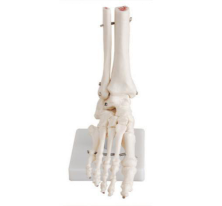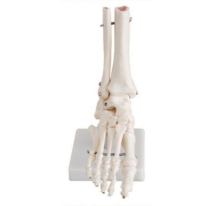
The complexity of foot anatomy from the model of big foot joint
Article tag: Foot acupuncture model medical acupuncture model

Through the model of the big foot joint, we can more intuitively understand the complexity of the foot anatomy. These models not only show the structure of the bones and joints of the foot, but also reveal the role of muscles, ligaments, nerves and blood vessels in foot function. By observing and operating these models, we can have a deeper understanding of the anatomical structure and functional characteristics of the foot, and provide valuable references for medical teaching, clinical trea...

Looking at the complexity of foot anatomy from the model of the big foot joint, we can more intuitively understand and appreciate the exquisite and complex structure of the foot. Here's a bit more on this topic:

I. Overview of the complexity of foot anatomy
Foot anatomy involves not just a single bone or joint, but a complex system of many bones, joints, muscles, ligaments, and nerves. These elements work together to perform various functions of the foot, such as supporting weight, walking, running, and adapting to different ground conditions.
Second, how does the big foot joint model reflect the complexity of foot anatomy
Bone and joint complexity:
The bigfoot joint model usually includes the major bones of the foot, such as the tarsals, metatarsals, and phalanges. These bones are connected to each other through multiple joints, forming a complex network.
The joint structures in the model, such as ankle joint, tarsal joint, tarsometatarsal joint, metatarsophalangeal joint and interphalangeal joint, show the diversity and complexity of foot joints. Each joint has its own specific range of motion and function, working together to achieve the various movements of the foot.
Muscle and ligament complexity:
The foot is home to many muscles and ligaments that not only generate strength, but also stabilize joints and protect bones and nerves.
Models of the joints of the big foot usually also show how these muscles and ligaments are distributed and connected. With the model, we can more intuitively see how they are distributed around the bones and joints, and understand their role in foot function.
Nerve and vascular complexity:
The foot also contains a rich network of nerves and blood vessels, which are responsible for transmitting sensory information and supplying nutrients.
While these structures may not be shown directly in most models of the big foot joint, their presence and importance is also an important indication of the complexity of foot anatomy.
Iii. Summary
Through the model of the big foot joint, we can more intuitively understand the complexity of the foot anatomy. These models not only show the structure of the bones and joints of the foot, but also reveal the role of muscles, ligaments, nerves and blood vessels in foot function. By observing and operating these models, we can have a deeper understanding of the anatomical structure and functional characteristics of the foot, and provide valuable references for medical teaching, clinical treatment and rehabilitation training.

Marketing Center
Hong Kong, ChinaProduction Base
Shanghai, ChinaProducts
Contact Us
 Address: Hong Kong, China
Address: Hong Kong, China
 Phone:+86 19937901373
Phone:+86 19937901373
 Email:sophia@adahealthy.com
Email:sophia@adahealthy.com
 Mobile:+86-0379-65160607
Mobile:+86-0379-65160607








